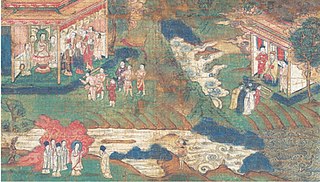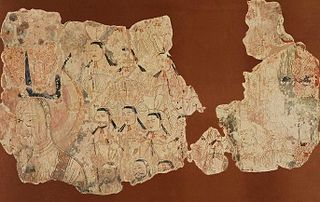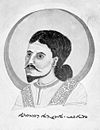
Manichaeism was a major religion founded in the 3rd century AD by the Parthian prophet Mani, in the Sasanian Empire.

Cao'an is a temple in Jinjiang, Fujian, Luoshan Town. Originally constructed by Chinese Manicheans, it was considered by later worshipers as a Buddhist temple. This "Manichean temple in Buddhist disguise" is seen by modern experts on Manichaeism as "the only extant Manichean temple in China", or "the only Manichean building which has survived intact".

Chinese Manichaeism مانویت چینی or ‘Religion of Light’ دین روشنی known as Monijiao (Chinese: 摩尼教; pinyin: Móníjiào; Wade–Giles: Mo2-ni2 Chiao4; lit. 'religion of Moni') or Mingjiao (Chinese: 明教; pinyin: Míngjiào; Wade–Giles: Ming2-Chiao4; lit. 'religion of light' or 'bright religion'), is the form of Manichaeism transmitted and practiced in China. It rose to prominence during the Tang dynasty and, despite frequent persecutions, continued long after the other forms of Manichaeism were eradicated in the West. The most complete set of surviving Manichaean writings were written in Chinese sometime before the 9th century and were found in the Mogao Caves among the Dunhuang manuscripts.

Sermon on Mani's Teaching of Salvation is a Yuan dynasty silk hanging scroll, measuring 142 × 59 centimetres and dating from the 13th century, with didactic themes: a multi-scenic narrative that depicts Mani's Teachings about the Salvation combines a sermon subscene with the depictions of soteriological teaching in the rest of the painting.
Bögü Qaghan or Tengri Qaghan — Third khagan of Uyghurs. He was the younger son of Bayanchur Khagan. His personal name was Yaoluoge Yidijian (藥羅葛移地健) and was titled Ulu Bilge Töles Shad during his father's reign. His subsequent regnal names upon inheriting the throne were Tarkhan Bögü Qaghan, Alp Külüg Bögü Qaghan, and finally Tengrida Qut Bolmish El Tutmish Alp Külüg Bilge Qaghan. He was posthumously renamed as Kün Tengrida Qut Bolmish El Tutmish Alp Külüg Bilge Qaghan by Baoyi Qaghan, stressing his adoption of the Manichean religion. Other titles granted to him were Yingyi Qaghan (英義可汗) - a Tang Dynasty invested title and Zahag-i Mani - a Manichaean title.

The Chinese Manichaean hymn scroll is a scroll found by British Archaeologist Aurel Stein found in the Mogao Grottoes Tang Dynasty Grottoes of Dunhuang, as Manichaeism Dunhuang Chinese triple one, is the ancient Chinese Manichaean Hymns used by Christians in religious ceremonies. Now in the collection of the British Library, number S.2659。

The Manichean Compendium, was found in the Mogao Cave Tibetan Scripture Cave of Dunhuang is a manuscript expounding the doctrine of Manicheaism, which was born in the reign of Emperor Xuanzong of Tang by the Persian missionary Fuduo Written in the nineteenth year of his reign (731), it briefly summarizes the basic teachings and rituals of the religion, and is an introductory document for understanding Manichaeism.

Incomplete scripture of Manichaeism, was discovered by British archaeologist Aurel Stein in Mogao Caves Tibetan The Tang Dynasty Manichean Posthumous Manuscripts of Jingdong is one of the Manichaeism Dunhuang Chinese Three Classics. Now in the collection of National Library of China, number BD00256.

In Manichaeism, Jesus is considered as one of the four prophets of this religion, along with Zoroaster, Gautama Buddha and Mani. is also a "Guiding deity" who greets the light bodies of the righteous after their deliverance.

Manichaean Temple Banner Number "MIK Ⅲ 6286" is A Manichaean monastery flag banners collected in Germany Berlin Asian Art Museum, made in the 10th century AD, and was German Turpan expedition team at the beginning of the 20th century Found in Xinjiang Gaochang. The flag streamer is 45.5 cm long and 16 cm wide, with painted portraits on both sides. It is a funeral streamer dedicated to the deceased Manichae believers.

Three Persian religions refers to the three religions that originated in Persia that were spread in China during the Tang period. They were recognized and protected by the Tang dynasty and prospered for a while.

Leaf from a Manichaean book MIK III 4974 is a fragment of Manichaean manuscripts collected in Germany Berlin Asian Art Museum, drawn in the 10th century, 20 At the beginning of the century, it was discovered by German Turpan expedition team in Xinjiang Gaochang Ancient City. The remaining page is 7.9 cm long and 15.5 cm wide, with an illuminated manuscript illustration drawn in the center of the front. The upper part of the book is written with Middle Persian Benediction The scriptures indicate that this fragment originally belonged to a Manichae Liturgical book.

Manichaean manuscript fragment number "MIK Ⅲ 4979" is a collection Fragments of Manichaean illuminated manuscript in Germany Berlin Asian Art Museum, painted during the 8th-9th centuries, and were found in the early 20th century. German Turpan expedition team found in Xinjiang Gaochang site. The broken page is 12.4 cm long and 25.2 cm wide, with slender painting illustrations drawn on both sides, written in Sogdian in Manuscript, Turkic and Middle Persian text.

Leaf from a Manichaean book MIK III 6368 is a fragment of Manichaean manuscripts collected in Germany Berlin Asian Art Museum, drawn during the 8th-9th centuries, Was discovered in Xinjiang by German Turpan expedition team in the early 20th century. The remaining page is 8.2 cm long and 11.0 cm wide, with slender painting illustrations on both sides, and the text is Sogdian.

Mani's Community Established is A Manichaen silk color painting drawn in the coastal area of southern China during the yuan to ming period, depicts the missionary history of Manichaeism and the establishment of its churches in three scenes. The preservation is intact and undamaged. This painting was originally part of a large Manichae silk painting, The drawing technique and artistic style are very similar to "Episodes from Mani's Missionary Work", "The Birth of Mani", "Mani's Parents" and "The Manichean Universe Map". The painting is now in a private collection in Japan.

Fragment of Manichaean Wall Painting "MIK Ⅲ 6918" is a fragment of a mural Manichaeism collected in Germany Berlin Asian Art Museum, painted around the 10th century AD, and was German Turpan expedition team found in the ruins of Gaochang in Xinjiang. The fragment is 88 centimeters long and 168.5 centimeters wide. It depicts a scene of worship in a Manichae church.
The Manichae stone sculptures of Shangwan Village refer to eight Ming-Qing slabs found in Shangwan Village, Xiapu County, Ningde City, Fujian Province in 2009.Numbers A1, A2, B, C1, C2, D1, D2, E, which have been verified by scholars as the relics of Manichaeism .These stone slabs were originally used to decorate the Three Buddha Pagodas and the Pangong Stone Pagoda. The inscriptions on the stone slabs indicate that the Three Buddhas Pagoda was built in the sixth year of Zhengde in the Ming Dynasty. According to Huang Yizhao’s "Tahou Village Cultural Relics", the three Buddhas The tower was originally three towers, one large and two small, which were later demolished during the Cultural Revolution.

Qianku is a Town under the jurisdiction of Cangnan County, Wenzhou City, Zhejiang Province, People's Republic of China. Located in the center of Jiangnanyang Plain in Cangnan County, with an area of 62.86 square kilometers and a population of 127,000 (2017), it has jurisdiction over Yangtou, Qianqianjin, Hengjie, Dongxi Street, Jinjiayang, Sanshiqiao communities, Xiakou and Xiangqiao, Xin'an, Xianju, Kuoshan, Chengnan, Chengbei districts, a total of 47 administrative villages. Qianku Town is known as a water town in the south of the Yangtze River due to its pleasant climate, beautiful environment and dense river network. Geographically, it is connected to Longgang City in the east, Wangli Town in the west, Yishan Town in the north, and Jinxiang Town and Chixi Town in the south. Existing Longjin Avenue and G1523 Ningbo-Dongguan Expressway. 228 National Highway, S216 Lin'an-Cangnan Expressway, Rui-Cang Expressway Qianku Section are under construction. Qianku Town was selected as the fourth batch of provincial-level small city cultivation pilot towns in Zhejiang Province, and successively won the luggage industry production base, China's comprehensive utilization of waste textile pilot base, Wenming Town, Zhejiang Province, Zhejiang Province Educational Strong Town, Zhejiang Province Provincial Sports Town, Zhejiang Province Ecological Civilization Town, Zhejiang Science Popularization Demonstration Town, Zhejiang Province-level Central Town, Zhejiang Province "New Countryside Impact Broadcasting" TV boosts ten characteristic towns, Zhejiang Province Happy Small Towns, Zhejiang Province Health Towns, Honorary titles such as Forest Towns in Zhejiang Province. In November 2020, Qianku Town became the fourth batch of small cities cultivation pilot in Zhejiang.

Manichaeism has a rich tradition of visual art, starting with Mani himself writing the Book of pictures
Baiyang (柏洋乡) township is a township -level administrative unit under the jurisdiction of Xiapu County, Ningde City, Fujian Province, People's Republic of China. In 2017, the administrative area was 17,289 hectares, and the permanent population was 10,676
















